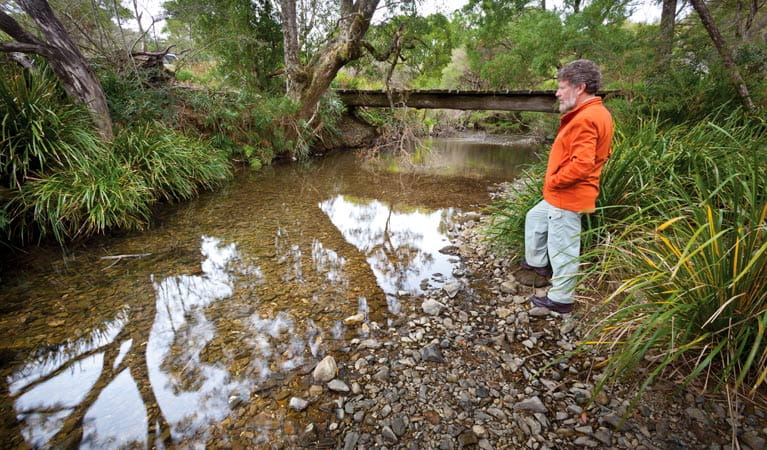Slingsbys trail and Syndicate Ridge track
Dorrigo National Park
Overview
Slingsbys trail and Syndicate Ridge track offer a challenging adventure in Dorrigo National Park, with opportunities for birdwatching, mountain biking and camping.
- Where
- Dorrigo National Park in North Coast
- Distance
- 15km one-way
- Time suggested
- 6 - 8hrs
- Grade
- Grade 5
- Trip Intention Form
-
It's a good idea to let someone know where you're going. Fill in a trip intention form to send important details about your trip to your emergency contact.
- Personal Locator Beacon
-
Hire a Personal Locator Beacon (PLB) for free at Dorrigo Rainforest Centre.
- What to
bring - Sunscreen, drinking water
- Please note
- This walk can be undertaken any time of year - but some sections of the track are at 900m above sea level so adequate clothing is required, especially in the cooler months.
Serious adventurers will love Slingsbys trail and Syndicate Ridge track, a challenging pathway across a variety of landscapes – from scenic grassy plains to a breathtaking escarpment and ancient Gondwana rainforest.
The walk begins along Slingsbys trail, stretching 6.5km to Lanes lookout along gently undulating terrain that’s also suitable for mountain biking. You’ll pass through the grasslands of Killungoondie Plain, which the Gunbaynggirr People once kept clear for hunting and camping by using spot fires. Today, it makes a surprising contrast to the surrounding rainforest, thick and atmospheric.
Eventually, you’ll reach high points along the escarpment, including Lanes lookout and Stony Creek lookout, with stunning scenic views on clear days across the surrounding landscape. Bring binoculars for birdwatching, but remember to look down around your feet too as Syndicate Ridge was the site of an innovative logging tramway that operated in the early twentieth century. Remnants of the back-breaking operation can still be seen around the trail.
Syndicate Ridge track from the escarpment is a much steeper and more difficult trail, so hiking experience is recommended. Signage is also limited here, so be sure to carry a compass and map or GPS.
Take a virtual tour of Slingsbys trail and Syndicate Ridge track captured with Google Street View Trekker.
Map
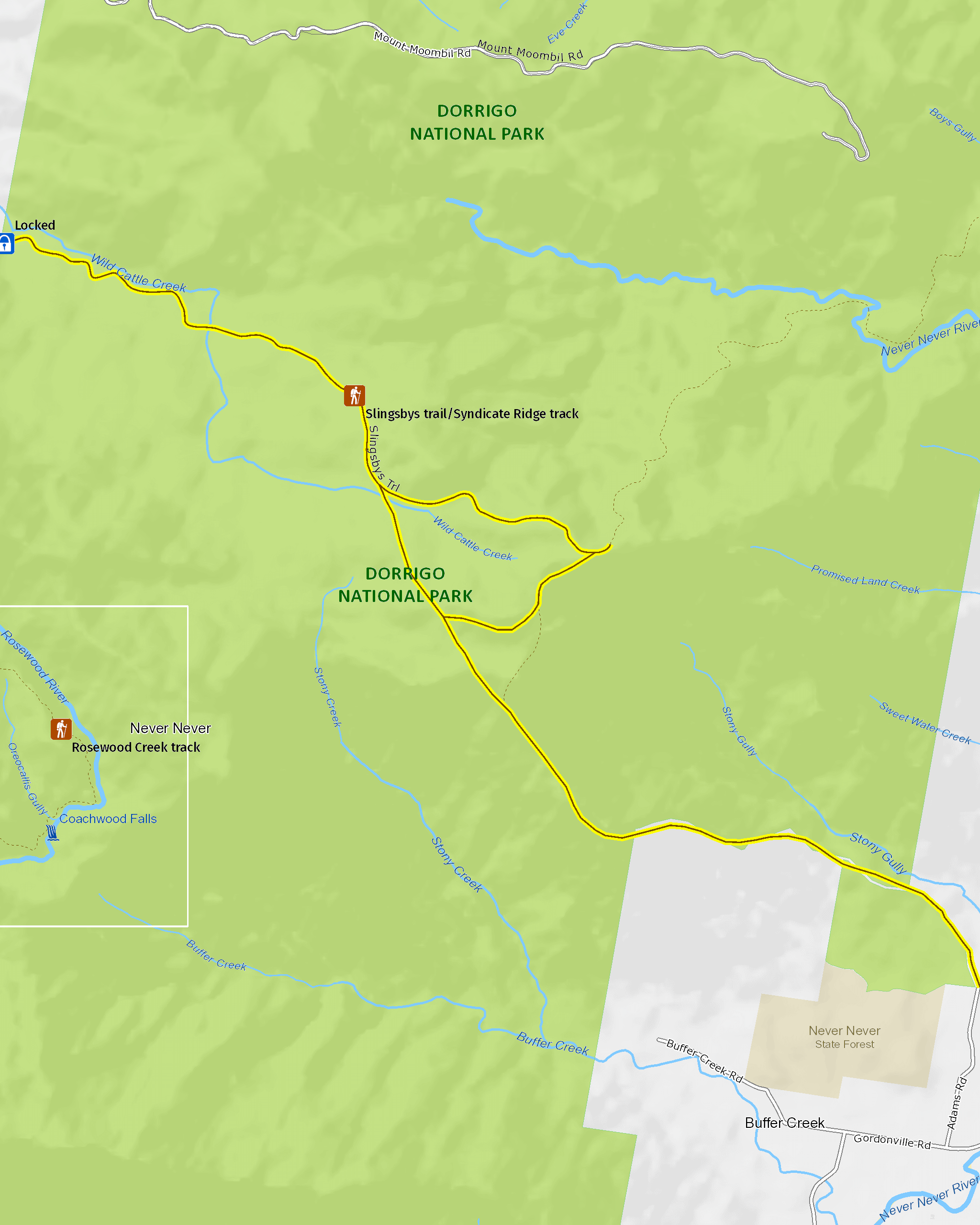
Map legend

Local alerts
For the latest updates on fires, closures and other alerts in this area, see https://www.nationalparks.nsw.gov.au/things-to-do/walking-tracks/slingsbys-trail-and-syndicate-ridge-track/local-alerts
General enquiries
- National Parks Contact Centre
- 7am to 7pm daily
- 1300 072 757 (13000 PARKS) for the cost of a local call within Australia excluding mobiles
- parks.info@environment.nsw.gov.au
Park info
- in Dorrigo National Park in the North Coast region
Dorrigo National Park is always open but may have to close at times due to poor weather or fire danger.
Visitor info
All the practical information you need to know about Slingsbys trail and Syndicate Ridge track.
Track grading
Features of this track
Distance
15km one-way
Time
6 - 8hrs
Quality of markings
Clearly sign posted
Experience required
Experienced bushwalkers
Gradient
Very steep and difficult
Steps
No steps
Quality of path
Rough track, many obstacles
Getting there and parking
Get driving directions
To start the walk along Slingsby trail:
- Drive 10km north of Dorrigo along Megan Road
- Turn onto Slingsby Road
- The trail begins at the end, and finishes at the northern end of Adams Lane, Glennifer.
Parking
Parking is available at the end of Slingsbys Road and at the end of Adams Lane, Gleniffer. Please do not block any farm gates with your vehicle at either of these locations.
Best times to visit
The weather at Dorrigo National Park can vary from warm to mild to cool, depending on the time of year you visit. The summer months usually have the highest rainfall.
Spring
The rainforest is alive with birdlife - walk the Lyrebird Link for a close up view.
Summer
Escape the summer heat along one of the waterfall tracks and feel the coolness envelope you.
Facilities
Drinking water is limited or not available in this area, so it’s a good idea to pack plenty of water.
Maps and downloads
Prohibited
Pets
Pets and domestic animals (other than certified assistance animals) are not permitted. Find out which regional parks allow dog walking and see the pets in parks policy for more information.
Smoking
NSW national parks are no smoking areas.
Visitor centre
-
Dorrigo Rainforest Centre
142 Dome Road Dorrigo Mountain NSW 2453 - 9am to 4.30pm daily. Closed Christmas Day.
- 02 6657 5913
Learn more
Slingsbys trail and Syndicate Ridge track is in Dorrigo National Park. Here are just some of the reasons why this park is special:
A wide range of animals
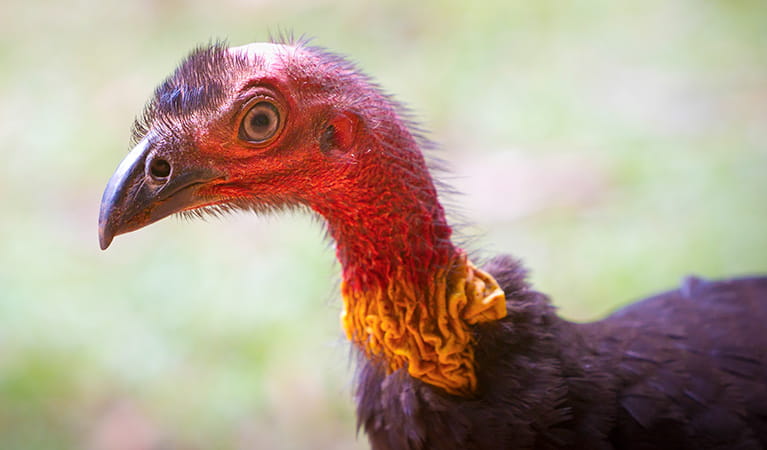
Dorrigo National Park plays home to many different animals, including 30 types of mammals, more than 128 kinds of birds and 44 species of amphibians and reptiles. The dense forest is the ideal hiding place for reptiles, so you'll need to be very quiet and patient in order to catch a glimpse. Look for the southern angle-headed dragon clinging to the trunks of trees along the Wonga walk and the red-necked pademelon on the lawn by the Rainforest Centre.
- 14-day coastal tours from Sydney to Cairns Unleash your spirit of adventure on a sweeping East Coast tour with Via Travel Australia. Let each new day bring more enchanting sites to discover and enjoy, from Gondwana Rainforests to cascading waterfalls and sublime surf beaches.
- Dorrigo kids’ nature play: 5 to 12 years Looking for something for the kids to do these school holidays? Join us for a fun tour in Dorrigo National Park, near Coffs Harbour. Kids aged 5 to 12 years can reconnect with nature through play.
- Dorrigo rainforest Aboriginal cultural tour These school holidays, bring the family to this tour in Dorrigo National Park, near Coffs Harbour. Gumbaynggirr Ranger Matt will share his language and culture as he guides you through the rainforest.
- Dorrigo Rainforest birds revealed self-guided audio tour Go on a self-guided audio tour through Dorrigo Rainforest and discover some of the interesting birds that call this place home. As you follow the track, you'll learn about the quirky habits, colourful personalities and unique calls of some of the park’s most prominent birds.
- Dorrigo rainforest ranger-guided tour Experience the rainforest like never before, on a ranger-guided walk through World Heritage-listed Dorrigo National Park. It's only 1hr from Coffs Harbour, but you'll feel worlds away.
Dramatic waterfalls
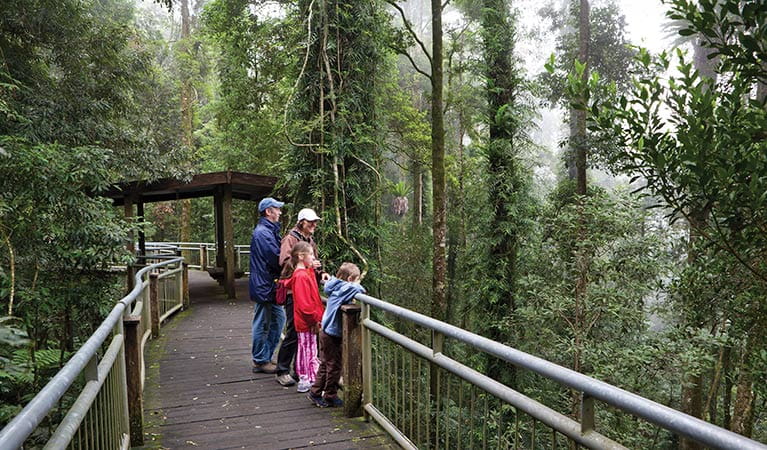
The area is renowned for its dramatic waterfalls; so much that part of the park was first reserved in 1901 to protect the Sherrard and Newell Falls along the Waterfall Way. Today, there are a number of great rainforest walks in the park, try the Crystal Shower Falls walk for a journey behind the falls, or the longer Casuarina Falls circuit that offers views of Dorrigo Mountain and Rosewood River Valley.
- Volunteer at Dorrigo Rainforest Centre Join a fun and passionate team of people when you become a volunteer at Dorrigo Rainforest Centre shop. Help show off Dorrigo National Park to visitors from around world. Explain the park’s activities and offer information about the nearby town of Dorrigo.
Rich Aboriginal heritage
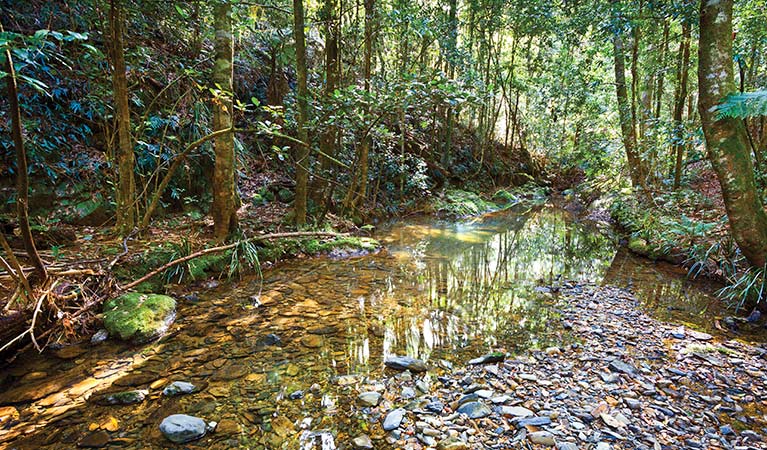
Dorrigo National Park aims to manage Aboriginal sites, many of which are associated with natural features in the landscape. Involving local Aboriginal custodians in managing their traditional homelands, and continuing their connection to country, is a priority in Dorrigo National Park.
- Dorrigo rainforest Aboriginal cultural tour These school holidays, bring the family to this tour in Dorrigo National Park, near Coffs Harbour. Gumbaynggirr Ranger Matt will share his language and culture as he guides you through the rainforest.
World Heritage rainforests
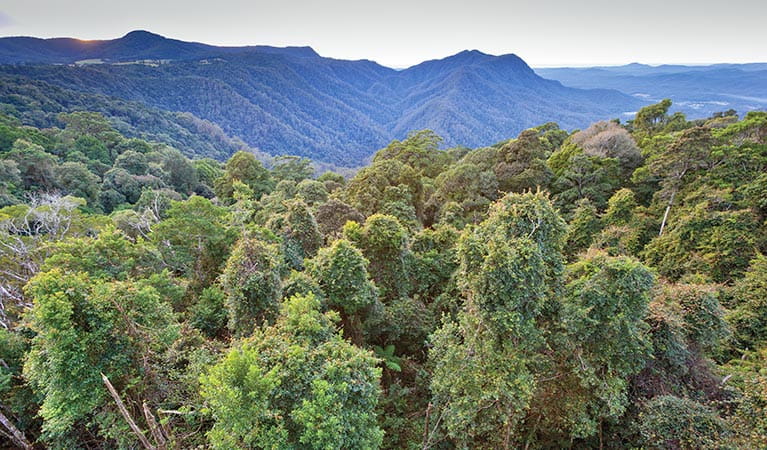
The rainforests in Dorrigo National Park are part of the Gondwana Rainforests of Australia World Heritage Area; the most extensive strip of diverse rainforest anywhere on earth. The World Heritage Area is a direct window into the past and the future, providing a link to the ancient pre-human world and a stunning and irreplaceable record of life on our planet. You can explore the rainforest on one of the many walking tracks, like the Lyrebird Link that leaves from the Rainforest Centre.
- 14-day coastal tours from Sydney to Cairns Unleash your spirit of adventure on a sweeping East Coast tour with Via Travel Australia. Let each new day bring more enchanting sites to discover and enjoy, from Gondwana Rainforests to cascading waterfalls and sublime surf beaches.
- 8-day NSW North Coast and Tablelands walking tour Join ParkTours for an 8-day walking holiday and discover the spectacular sights of the NSW North Coast and Northern Tablelands. Explore country towns, see stunning landscapes and go wildlife spotting.
- Dorrigo kids’ nature play: 5 to 12 years Looking for something for the kids to do these school holidays? Join us for a fun tour in Dorrigo National Park, near Coffs Harbour. Kids aged 5 to 12 years can reconnect with nature through play.
- Dorrigo rainforest Aboriginal cultural tour These school holidays, bring the family to this tour in Dorrigo National Park, near Coffs Harbour. Gumbaynggirr Ranger Matt will share his language and culture as he guides you through the rainforest.
- Dorrigo rainforest ranger-guided tour Experience the rainforest like never before, on a ranger-guided walk through World Heritage-listed Dorrigo National Park. It's only 1hr from Coffs Harbour, but you'll feel worlds away.
Plants and animals protected in this park
Animals
-
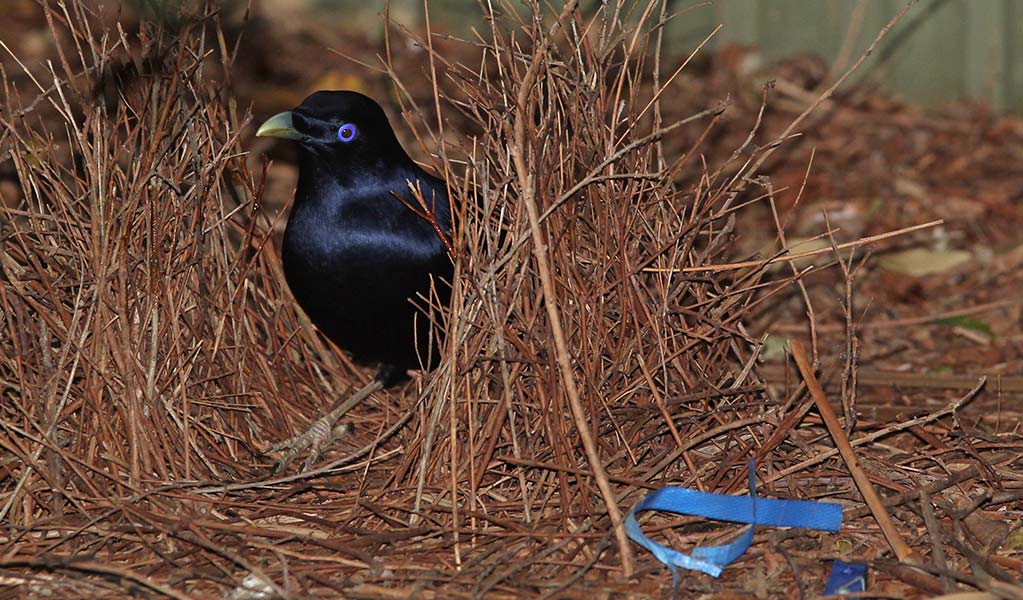
Satin bowerbird (Ptilonorhynchus violaceus)
With vibrant blue-violet eyes and curious antics, the satin bowerbird is a favourite for bird watching and easy to spot as it forages for food in open forest. Relatively common across eastern Australia, in NSW they’re found in coastal rainforests and adjacent woodlands and mountain ranges.
-
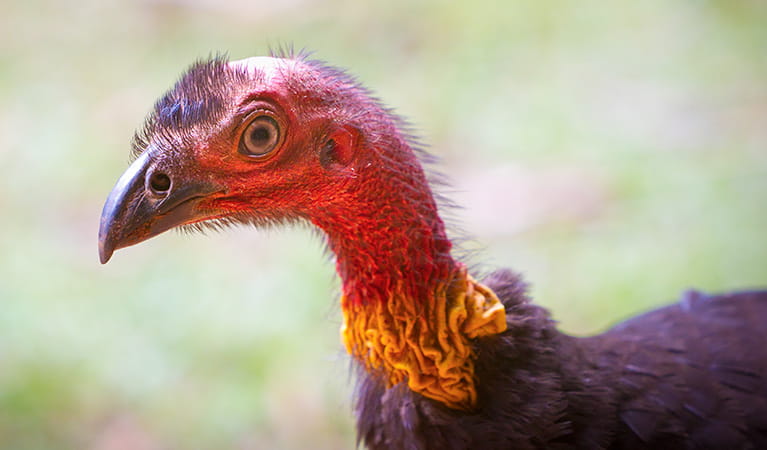
Australian brush turkey (Alectura lathami)
The Australian brush turkey, also known as bush or scrub turkey, can be found in rainforests along eastern NSW. With a striking red head, blue-black plumage and booming call, these distinctive Australian birds are easy to spot while bird watching in several NSW national parks.
-

Superb lyrebird (Menura novaehollandiae)
With a complex mimicking call and an elaborate courtship dance to match, the superb lyrebird is one of the most spectacular Australian animals. A bird watching must-see, the superb lyrebird can be found in rainforests and wet woodlands across eastern NSW and Victoria.
-

Common ringtail possum (Pseudocheirus peregrinus)
Commonly found in forests, woodlands and leafy gardens across eastern NSW, the Australian ringtail possum is a tree-dwelling marsupial. With a powerful tail perfectly adapted to grasp objects, it forages in trees for eucalypt leaves, flowers and fruit.
-
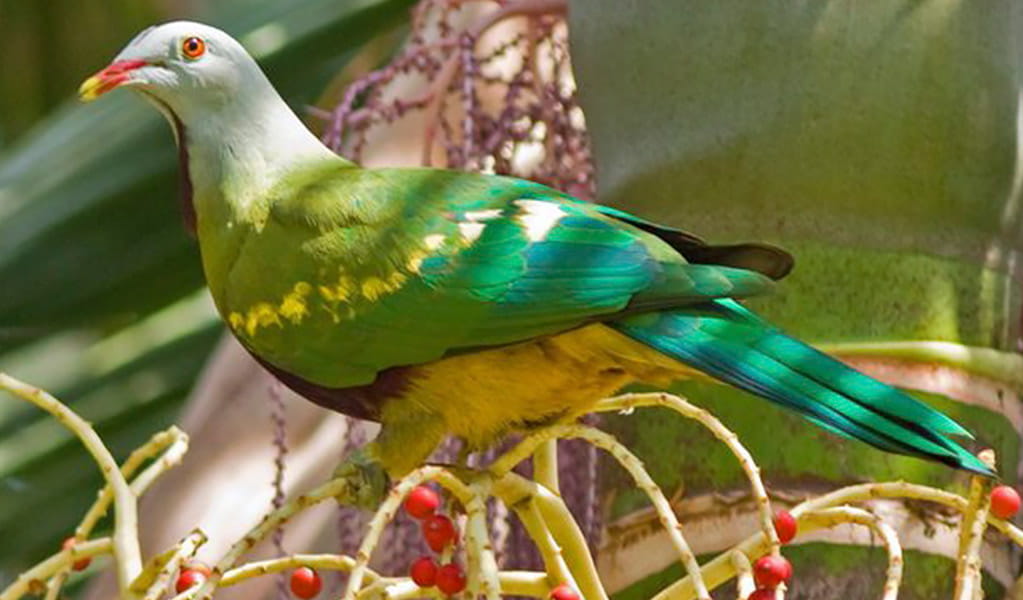
Wompoo fruit-dove (Ptilinopus magnificus)
The wompoo fruit-dove is a marvellously multi-coloured pigeon that makes its home in rainforest along coastal ranges from mid-north NSW to southern Queensland. It’s protected as a vulnerable species in NSW.
Plants
-
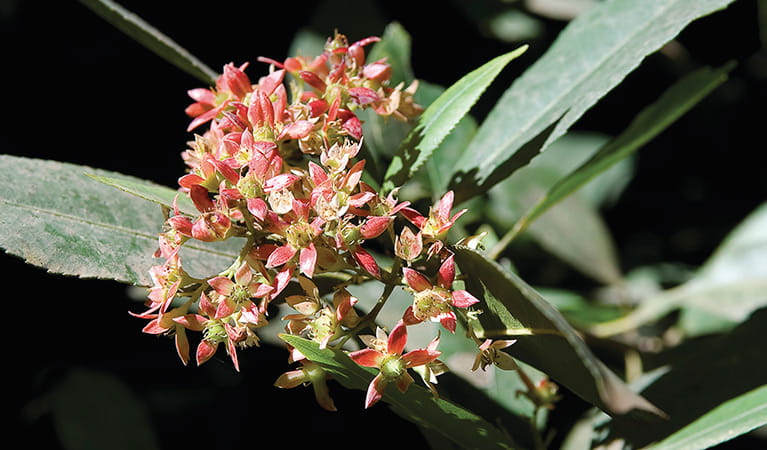
Coachwood (Ceratopetalum apetalum)
Coachwood trees are Australian native plants that grow in warm temperate rainforests along coastal NSW. Also known as scented satinwood, the mottled grey bark of the coachwood has horizontal markings and a delicate fragrance.
Environments in this park
Education resources (1)
School excursions (6)
- Sensing the rainforest at Dorrigo, Stage 2 (Years 3-4), Geography
- Venture to the falls, Stage 4 (Years 7-8), Geography
- Ecosystems at risk, Stage 6 (Years 11-12), Geography
- Sensing the rainforest at Dorrigo National Park, Stage 3 (Years 5-6), Geography
- Sensing the Rainforest, Stage 1 (Years 1-2), Geography
- Venture to the falls at Dorrigo, Stage 3 (Years 5-6), Geography

